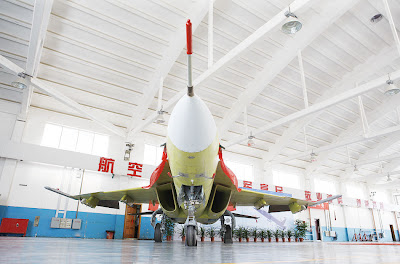 L-15 Attack Version (photo : defence.pk forums)
L-15 Attack Version (photo : defence.pk forums)China's Hongdu Aviation Industry Corporation (HAIC) has completed production of the first attack and supersonic trainer version of its L-15 Falcon jet trainer, the state-owned company announced on 18 August.
The aircraft is a modernised version of previous platforms and achieves additional power through the installation of two AI-222-25F afterburning turbojet engines supplied by Ukraine's Ivchenko-Progress design bureau. Previous versions of the L-15 were powered by Ukraine's ZMKB Progress DV-2 engines.
HAIC said in a statement that the first attack L-15 rolled off its production lines on 15 August after being in production for six months. The aircraft, which is currently being marketed to both domestic and export customers, is expected to undergo a series of tests before serial production commences.
The AI-222-25F engine generates 4,200 kg of thrust in afterburn, offering aircraft in the class of the L-15 speeds of up to M1.6.
 L-15 attack version in the Chinese magazine (photo : Shipboorne Weapons)
L-15 attack version in the Chinese magazine (photo : Shipboorne Weapons)Jane's understands that the installation of AI-222-25F engines highlights some of the capability gaps that China's defence industry is attempting to fill over the next decade through reverse engineering of existing products and systems and indigenous research and development (R&D) programmes.
Chinese defence industry has been developing jet engines for fighter aircraft for many years, but has so far been unable to design, develop and produce a power plant that is sufficiently powerful and reliable.
In a bid to overcome these problems, China's Aviation Industry Corporation announced in May its plans to invest in expanding gas turbine engine development capabilities and implement a five-year plan to reform its related manufacturing divisions, although foreign technologies will still be sought.
The group said it would establish a chain of engine R&D centres, competency centres and a gas turbine "manufacturing centre of excellence". It will also seek to improve collaboration with local industries in China and "strengthen international co-operation" in a bid to facilitate technology exchanges.